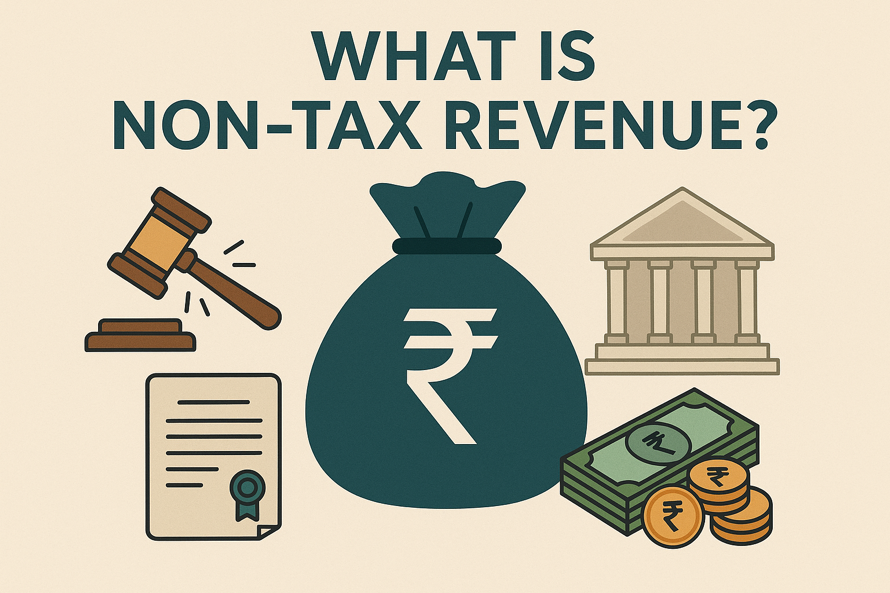
Non-tax revenue refers to the amount the government receives from sources unrelated to taxes. It is a significant source of funding for the government, helping to raise funds for vital services and national welfare.
To understand how the government funds public services from non-tax revenues, people and companies need to understand non-tax revenue, its sources, significance, and examples. In this blog post, we will explain all you need to learn about non-tax revenue in India.
Introduction to Government Revenue
To cover their expenses and maintain public services, governments depend on several sources. These sources are broadly classified as government revenue. This is the income earned by the government for funding its operations, development programs, social welfare schemes, infrastructure, and defense.
Tax revenue and non-tax revenue are the two primary sources of government income, which is the lifeblood of fiscal policy. While taxes are often the primary component, non-tax revenue is equally important, particularly in closing budget deficits and preserving budgetary balance. For fiscal year 2026, India’s Union Budget projected gross tax revenue of over 42 trillion Indian rupees.
Classification of Revenue: Tax vs Non-Tax
The two types of government revenue are tax revenue, which is obtained by imposing various taxes on individuals and businesses, and non-tax revenue, which is generated through other non-coercive means.
This difference is crucial because it illustrates various methods of collecting and represents differing degrees of coercion and purpose. Therefore, knowing this categorization makes it easier to examine how governments organize, set priorities, and implement their budgetary plans.
Why Non-Tax Revenue is Important in Fiscal Planning
Tax revenues are a big part of the government’s income, but non-tax revenue is also significant. It comes in handy when the economy is slowing down and tax payments may not be sufficient.
Additionally, non-tax revenue helps maintain a government’s financial stability and enables it to meet significant obligations without increasing taxes excessively. Diversifying sources of revenue and reducing reliance on taxes alone also helps maintain budgetary restraint.
Definition and Meaning of Non-Tax Revenue
Non-tax revenue is the income that a government earns. This income comes from various administrative, commercial, and legal activities rather than from taxes. They typically gather it as a fee for services. It can also come from returns on government investments or penalties and regulatory charges. Non-tax revenue differs from tax revenue. The general public contributes to this only if they engage in specific transactions or use certain services.
What Constitutes Non-Tax Revenue?
Non-tax revenue may originate from a variety of sources. It comprises government service fees, revenues from public-sector activities, royalties, loan interest, and rentals from government assets. This money might be one-time or ongoing, and it may include donations or grants from domestic or international entities. Its varied sources make it a versatile and adaptable source of revenue.
Who Collects Non-Tax Revenue in India?
Both the state and the central governments in India collect non-tax income. Specific source management is within the purview of many ministries and departments. Furthermore, different regulatory bodies, courts, and administrative offices also contribute to collecting non-tax revenue through fines, charges, and fees. The money thus collected is deposited into the government treasury.
Major Sources of Non-Tax Revenue in India
In India, non-tax revenue comes from several sources. Every source is gathered differently, yet they are all relevant in the larger economic picture.
Interest Receipts on Loans
The government provides loans to state governments, public sector businesses, and other organizations. A significant portion of non-tax income comes from the interest paid on these loans. These receipts are crucial for overseeing the financial ecosystem as they show the return on the government’s financial holdings.
Dividends and Profits from Public Sector Enterprises
Public sector firms, which the government entirely or partly controls, generate non-tax income via dividends and earnings. These returns encourage capital expenditures by the state and promote budgetary sustainability.
Fees and Fines
For the issuance of licenses, certificates, permits, and other services, government agencies collect fees. Meanwhile, breaches of the law, traffic offences, and regulatory violations are subject to fines and penalties. These collections add up to a lot and also serve to strengthen adherence to legal and regulatory requirements.
Spectrum and License Fees
Fees for telecom spectrum allocation, broadcasting rights, and other licensing agreements generate significant non-tax revenue. Private companies often use public resources or infrastructure to make these kinds of payments.
Rent from Government Properties
The government owns numerous residential and commercial properties. When they are rented or leased, the rent earned is considered non-tax revenue. Buildings, land, and other public assets are examples of such properties.
Grants and Contributions
Governments may get donations from both domestic and international organizations. Some of these funds might be for disaster relief, development support, or specific projects. These donations, however irregular, may significantly strengthen the state’s finances during difficult times.
Differences Between Tax and Non-Tax Revenue
Gaining knowledge about the difference between tax and non-tax revenue helps one understand the government’s budgetary structure.
Legal Basis and Compulsion
All individuals who earn income above a certain threshold, as well as companies, must pay taxes, which are legally required payments. On the other hand, non-tax income is dependent on license ownership or service usage. In contrast to legal obligations, it is more often a result of transactions.
Voluntary Nature of Non-Tax Collections
In jurisdictions where taxes are imposed, the majority of non-tax payments are either voluntary or transactional. For instance, the payment of a fee for a passport is not a mandatory requirement but rather a choice that is related to the decision of an individual to acquire a passport.
Examples and Impact on Budget
Court fees, museum entry fees, and profits from state-owned businesses are examples of non-tax revenue, while income tax and goods and services tax are examples of tax revenue. Although the amount collected is often lower, non-tax revenues are nonetheless essential for maintaining a budget balance.
Role of Non-Tax Revenue in India’s Union Budget
Non-tax revenue is a significant portion of India’s Union Budget. It helps the nation collect more money and lowers its fiscal imbalance. It provides the government with more financial freedom, adds to tax income, and enables it to pay for services without raising taxes. Non-tax revenue often fills the gap to provide stability when the economy performs poorly, and tax revenues decline.
Share of Non-Tax Revenue in Total Revenue Receipts
Even though the proportion of non-tax revenue would fluctuate, it always makes up a part of the total revenue structure. The share often relies on the profitability of public sector units. It also depends on the efficiency of administrative fee collection and the receipt of significant one-time revenues such as auction proceeds or grants.
Trends in Non-Tax Revenue (2020–2025)
India’s non-tax revenue has been slowly changing over the past few years. Monetization of assets, streamlining service fees, and digitalizing collections are all essential. These changes are expected to enhance accountability and transparency.
Policy Measures to Boost Non-Tax Income
The government recognizes the importance of non-tax revenue and pursues key measures like fee reduction, strategic disinvestment, and asset monetization. It promotes public-private partnerships and applies technology for the automation of collection. These programs enhance the reliability, stability, and integration of non-tax revenue into long-term budgeting and resource planning.
Challenges in Non-Tax Revenue Collection
Although it’s crucial, collecting non-tax revenue presents challenges. These concerns may restrict its full potential and involvement in fiscal consolidation.
Inconsistent Profitability of PSUs
Public sector undertakings, which are intended to generate a steady stream of revenue, often struggle with inefficiencies and losses. This unreliability impacts projected revenue as well as financial projections.
Administrative Bottlenecks
Collection of non-tax dues is often delayed due to bureaucratic red tape, inadequate departmental cooperation, and a lack of enforcement measures. Weak infrastructure may also hinder the proper monitoring and collection of fines, fees, and levies.
Need for Transparent Monetization Frameworks
To prevent erroneous prices and abuse, government schemes such as asset conversion require transparent legal and regulatory frameworks. The realization of revenues from public assets could be reduced, and private participation could be discouraged by lack of transparency.
Conclusion
A crucial component of a government’s financial resources is non-tax revenue. It boosts government revenue, enhances service delivery, and stabilizes the economy. The money comes from interest, dividends, administrative fees, and more in India.
Policy changes and technology adoption can help overcome administrative inefficiencies and improve PSU performance. Strengthening non-tax revenue drives fiscal discipline, reduces deficits, and fosters inclusive growth.
FAQs
Q. What is included in the non-tax revenue of the government?
Income under various heads is included in the government’s non-tax revenue. Some of them are interest on loans, income from public sector units, fees for government services, penalties, licensing fees, and rent from government properties.
Q. How is non-tax revenue different from direct and indirect taxes?
Non-tax revenue is not mandatory, unlike direct taxes such as income tax or indirect taxes like GST. It is derived from administrative decisions, investments, or services.
Q. Why is non-tax revenue important for the Indian economy?
Non-tax revenue helps balance the budget gap, enabling the government to provide public services without increasing taxes. Besides, it helps to maintain fiscal stability.
Q. What are the top contributors to non-tax revenue in India?
Dividends from PSUs, interest receipts, charges for spectrum auctions, administrative fees, and recoveries from state-owned property are significant contributors to non-tax revenue in India.
Q. Can non-tax revenue reduce the fiscal deficit?
Yes, non-tax revenue helps bridge the fiscal deficit gap in India, as the government would not have to strain the citizens with high taxes. Income such as PSU dividends and the receipt of interest are significant in bringing down the fiscal deficit.




